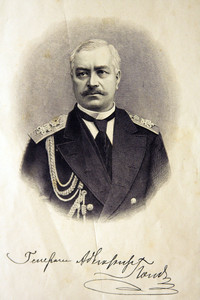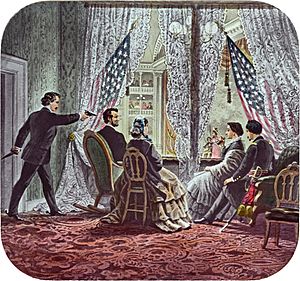Australia and the American Civil War facts for kids
Even though Australia was far away from the American Civil War, it was still affected. The war changed Australia's economy and brought new people to its shores. For example, England needed cotton, and since they couldn't get it from America, Australia's cotton became very important. Australia also helped supply ships from the Confederate side. Many people from Europe chose to move to Australia instead of war-torn North America, looking for a better life.
Australians were surprised when a Russian officer claimed Russia had a secret plan. He said Russia would attack British ships if Britain recognized the Confederacy. The Russian navy had just visited Australia, which made people nervous. This fear led to Australia building stronger coastal defenses and even buying a powerful ironclad warship.
Australia became directly involved when a Confederate warship, the CSS Shenandoah, visited for repairs. The American Union representative in Melbourne protested this visit. However, people in nearby Williamstown welcomed the Confederates. Some Australians even joined the ship's crew! It's not clear if Australians generally supported the Union or the Confederacy. But when news of Abraham Lincoln's death reached Sydney, many sad demonstrations were held.
Contents
How the War Affected Australia's Money (Economics)
About 140 Australians and New Zealanders fought in the American Civil War. Around 100 of them were born in Australia. Some were Americans who came to Australia during the Victorian gold rush in the 1850s. Among the officers was one who helped set up Tasmania's first telegraph service. Another officer mined for gold in Ballarat.
Confederate ships, called blockade runners, sometimes got supplies in Australia. This happened even though Australians had long worried about possible naval attacks from Americans. This fear came from American privateers during the War of 1812.
The war also caused a big problem called the Lancashire Cotton Famine in England. Because of this, Queensland's cotton industry grew. A group called the National Colonial Emigration Society was started in Britain to help. Many people in northern England lost their jobs because the Southern United States couldn't ship cotton during the war. After the war ended, England didn't buy much cotton from Southern Australia. But some Australians became interested in buying the Fiji Islands and their cotton fields.
Another effect was that Australia and New Zealand competed with Canada for Irish immigrants. More Irish people came to Australia and New Zealand, which was good for their economies. One reason for this increase was that many Irish people decided not to move to North America because of the war.
During the Civil War, the Union (USA) and Russia were allies. They saw Britain as a possible enemy. The Russian navy had ships in San Francisco and later in New York. These ships had secret orders to attack British naval targets if a war started between the United States and Britain. This war could have happened if Britain officially recognized the Confederacy.
The main ship of the Russian Pacific squadron, the Bogatyr, visited Melbourne in early 1863. It was an official friendly visit. However, in June 1864, Australian officials received surprising news. A Polish lieutenant named Władysław Zbyszewski, who had left the Bogatyr ship, claimed that the Russian Admiral A.A. Popov had secret orders. These orders were to attack British ships near Australia and even shell cities like Melbourne, Sydney, and Hobart. Similar attack orders were given to another Russian squadron sent to New York at the same time.
The CSS Shenandoah Visits Australia
The CSS Shenandoah, a Confederate warship, arrived in Australian waters on January 17, 1865. Off the coast of South Australia, its crew saw an American ship called the Nimrod. They boarded it but found it was an English ship, so they left it alone.
On January 25, 1865, the Shenandoah docked at Williamstown, Victoria, near Melbourne. It needed repairs after capturing Union whaling ships. Captain Waddell asked local authorities for permission to fix his ship, and they agreed. However, the United States consul, William Blanchard, wanted the Victorian government to arrest the Confederates as pirates. But Victoria's governor, Sir Charles Henry Darling, didn't agree. He was satisfied that the Shenandoah was just asking for repairs and claiming to be neutral. There were a few fights between Americans in Melbourne, but no direct battles. Eighteen crew members left the ship while it was in port. There were also worries that Northern supporters might join the crew to try and capture the ship at sea.
People in the area were very interested in the Confederate ship in Port Phillip Bay. While in Williamstown, Captain James Iredell Waddell and his men attended several events. Local citizens arranged these events in their honor. This included a fancy ball with important people at Craig's Royal Hotel in Ballarat and at the Melbourne Club. Thousands of tourists came to see the ship every day, and special trains were needed to bring them.
After leaving Australia, the Shenandoah sailed north into the Pacific Ocean. It captured 25 more Union whaling ships. Finally, it surrendered in Liverpool, England, in November 1865. Among those who surrendered were 42 Australians who had joined the crew in Williamstown. It's not clear if they were secret passengers (stowaways) or if they were illegally recruited.
Before sailing from Williamstown on February 18, 1865, Captain Waddell did not let Australian authorities check if Australians were on board. Four Australians were arrested to stop them from joining the Confederate ships. Governor Darling allowed the Shenandoah to sail away instead of firing on it. Waddell's official report said that on February 18, they "found on board" the 42 men. He said 36 became sailors and six became marines. One of the original Confederate crewmen said they just happened to find the stowaways, who were from different countries, and enlisted them outside Australian waters. He also said one of the stowaways was the captain of an English ship that was in Melbourne at the time. This Englishman became the captain's assistant.
Abraham Lincoln's Death
News of Abraham Lincoln's assassination on April 14, 1865, caused great sadness in Sydney. An article in Melbourne's "The Age" newspaper on June 27, 1865, reported that Lincoln's death caused strong anger in Sydney. Many Australians supported putting an end to slavery, which was a key issue for Lincoln and his Emancipation Proclamation. A memorial service was held in Sydney's Prince of Wales Opera House on Sunday, July 9, 1865. People at public meetings were very angry at Lincoln's killer. They saw Lincoln as a brilliant person who rose "from a log cabin to the White House."
A public meeting was held in Sydney to show sympathy for Lincoln's death. A meeting of American citizens on June 26, 1865, decided to send a letter of condolence to Mrs. Lincoln. They also planned to contribute to a memorial and wear black for a month. The mayor of Sydney sent a letter of sympathy to Lincoln's wife.
News of Lincoln's assassination was reported in Melbourne's "The Age" on June 24, 1865. Editorials in Melbourne newspapers were very noticeable. The Melbourne Herald on June 26, 1865, mentioned that many American businesses in town flew their flags at half-mast. This was to show respect for the late President. William Blanchard, the U.S. Consul in Melbourne, kept the consular flag at half-mast until July 4, 1865. The City Council of Melbourne passed a resolution. It expressed its "horror and detestation of the atrocious murder of the late Chief Magistrate."
Other letters of sympathy came from Australia. They were from Polish and Hungarian Refugees in Melbourne (July 4, 1865), Citizens of the Swiss Republic Residents in New South Wales, Sydney Irish National League, NSW Branch (July 22, 1865), and the mayor of Sydney Municipal Council (July 17, 1865). Another letter came from the town of Geelong in Victoria, addressed to "Mrs. Lincoln, Washington, America" (August 22, 1865).
What Happened Next (Aftermath)
After the war, people in Melbourne realized they could be attacked, especially by the Russians. So, they quickly built coastal defense forts. The government of Victoria asked for an ironclad ship to protect the colony. This was because ironclads had proven how strong they were during the American Civil War's Battle of Hampton Roads. The monitor HMVS Cerberus was built in the late 1860s and arrived in Victoria in 1871.
In 1872, the British government paid the United States $3,875,000. This was because of the help given to CSS Shenandoah and other Confederate ships in Victoria and other British ports. An international group in Geneva, Switzerland made this ruling.
In 1972, the American Civil War Round Table of Australia was started. Its secretary, Barry Crompton, has the largest library about the American Civil War outside the United States. As of 2005, it had over 4,000 items.
Australia's Self-Government
When the six Australian colonies joined together to form their own nation in 1901, Australia chose to follow the British style of government. They had concerns about America's powerful presidency after the war. Australians also did not want to bring in "coloured labour." This was partly due to fears of a civil war like the one in America. To prevent this, the word "indissoluble" was added to Australia's Federal Constitution in 1897–1898 in Adelaide. This was to stop any idea of a state leaving the country, like the Confederacy did.
See Also
- Australia–United States relations







